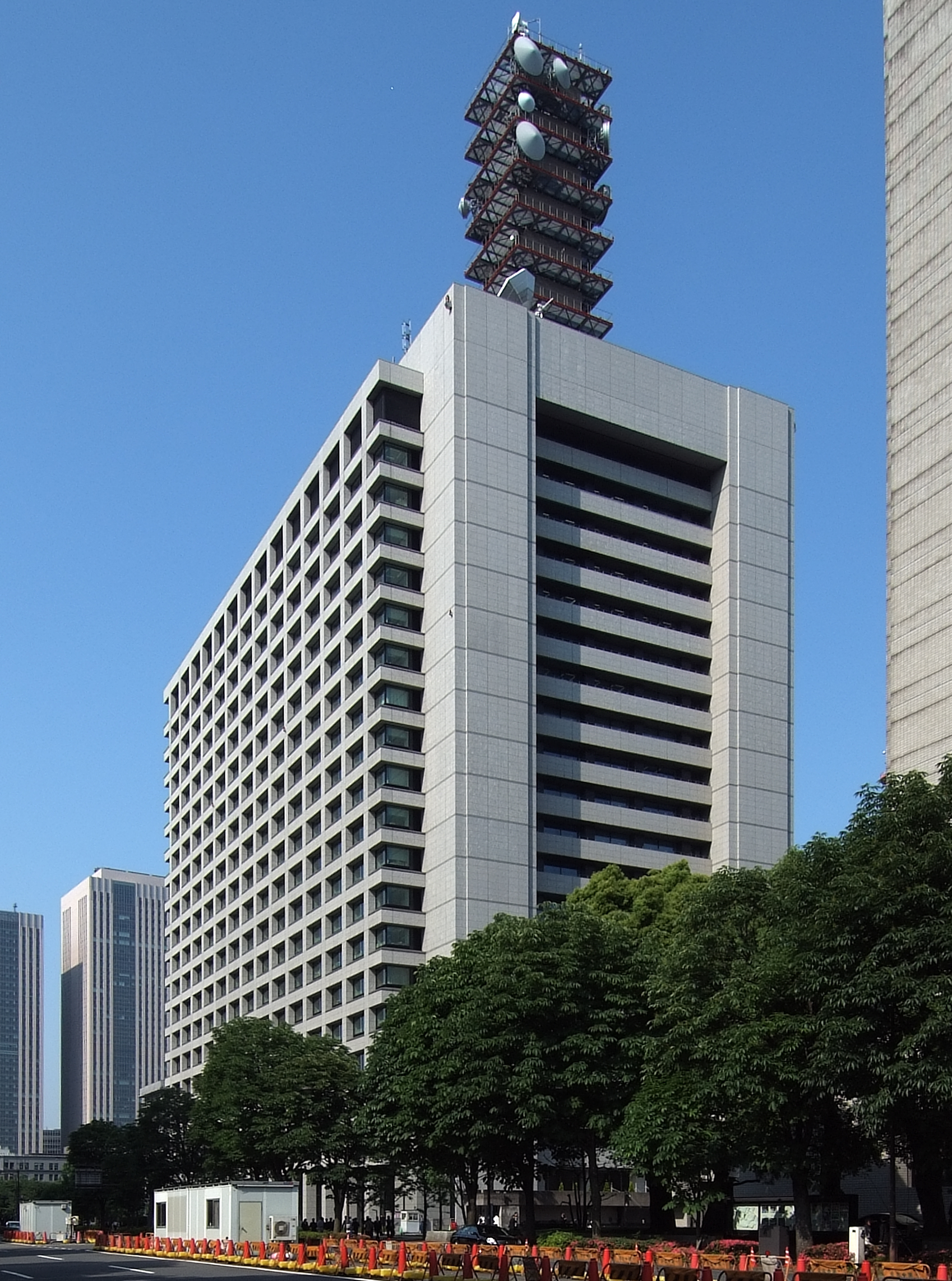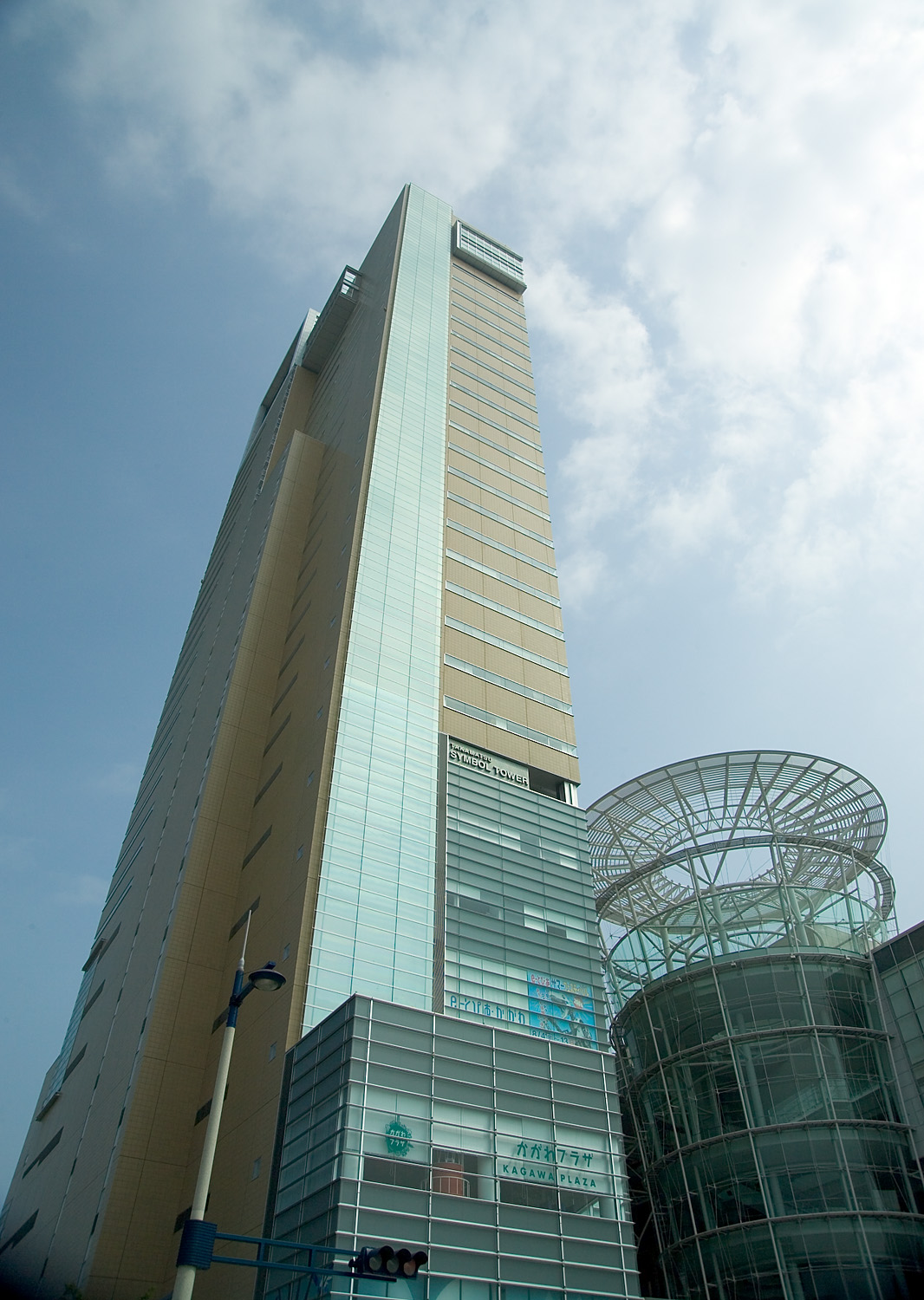|
Kawaramachi Station (Kagawa)
is a railway station located in the city of Takamatsu, Kagawa, Japan. It is operated by the private transportation company Takamatsu-Kotohira Electric Railroad (Kotoden) and has station designations "K02", "N02" and "S00". Lines Kawaramachi Station is served by the Kotoden Kotohira Line, Kotoden Nagao Line, and Kotoden Shido Line. It forms the terminus of the 14.6 kilometer Kotoden Nagao Line to and the 12.5 kilometer Kotoden Shido Line to , although many Nagao Line services start and terminate at Takamatsu-Chikkō Station. It is located 32.9 km from the opposing terminus of the Kotohira line at Kotoden-Kotohira Station. Layout The station is an elevated station integrated with the Kotoden Kawaramachi Building completed in 1996, and the Kotohira Line and Nagao Line platforms are located on the first floor of the building. The Kotohira Line has one island platform and two tracks (platforms 1 and 2), and the Nagao Line has one side platform A side platform (also known ... [...More Info...] [...Related Items...] OR: [Wikipedia] [Google] [Baidu] |
Kotoden Logo V
, officially for short, is a transportation company in Kagawa Prefecture, on the island of Shikoku, Japan. With headquarters in Takamatsu, the company operates three passenger railway lines, as well as bus subsidiaries. It was established on 1 November 1943. In 2021, it reported sales of ¥2,881,000,000 with a capitalization of ¥250,000,000. History The company traces its origins to 1909, when was founded. This company opened the Nagao line on 30 April 1912 between Dehare (出晴) (close to the present Kawaramachi Station) and Nagao Station. The line was originally 1,067 mm (3 ft 6 in) gauge and electrified at 600V DC, but it was regauged to 1,435 mm (4 ft 8+1⁄2 in) in June 1945, and the overhead line voltage was raised to 1500V DC in December 1976. In 1910, was established, and opened the Shido line on 18 November 1911 between Imabashi and Shido Station (now Kotoden-Shido). The line was electrified at 600V DC, and increased to 1500V DC in August 196 ... [...More Info...] [...Related Items...] OR: [Wikipedia] [Google] [Baidu] |
Kotoden Kotohira Line
The is a Japanese railway line in Kagawa Prefecture, which connects Takamatsu-Chikkō Station in Takamatsu with Kotoden-Kotohira Station in Kotohira. It is owned and operated by the Takamatsu-Kotohira Electric Railroad. The line color is yellow. History The line first opened on 21 December 1926 between Ritsurin-Kōen and Takinomiya. The line was later extended on both sides to Kotoden-Kotohira and Kawarachō in 1927. Since the beginning of the 21st century, three new stations have opened: on 29 July 2006, on 15 December 2013, and Fuseishi on 28 November 2020. Currently, a new station named Tahi Station is planned to open in 2026. Stations All stations are located in Kagawa Prefecture is a Prefectures of Japan, prefecture of Japan located on the island of Shikoku. Kagawa Prefecture has a population of 949,358 (as of 2020) and is the List of Japanese prefectures by area, smallest prefecture by geographic area at . Kagawa Pr .... ** indicates staffed station. Ridersh ... [...More Info...] [...Related Items...] OR: [Wikipedia] [Google] [Baidu] |
Kotoden Nagao Line
The is a Japanese railway line in Kagawa Prefecture, which connects Kawaramachi Station (Kagawa), Kawaramachi Station in Takamatsu, Kagawa, Takamatsu with Nagao Station (Kagawa), Nagao Station in Sanuki, Kagawa, Sanuki. It is owned and operated by the Takamatsu-Kotohira Electric Railroad. The line color is green. Station list All stations are located in Kagawa Prefecture. Station number "N00" is used for Takamatsu-Chikkō Station, and "N01" is for Kataharamachi Station (Kagawa), Kataharamachi Station on the Kotohira Line. History The line first opened as the on 30 April 1912 between (close to the present Kawaramachi Station) and Nagao. The line was originally gauge and electrified at 600 V DC, but it was regauged to in June 1945, and the overhead line voltage was raised to 1,500 V from December 1976. References {{reflist Rail transport in Kagawa Prefecture Lines of Takamatsu-Kotohira Electric Railroad, Nagao Line Standard-gauge railways in Japan Articles contain ... [...More Info...] [...Related Items...] OR: [Wikipedia] [Google] [Baidu] |
Kotoden Shido Line
The is a Japanese railway line in Kagawa Prefecture, which connects Kawaramachi Station in Takamatsu with Kotoden-Shido Station in Sanuki. It is owned and operated by the Takamatsu-Kotohira Electric Railroad. The line color is rose pink. Station list All stations are located in Kagawa Prefecture is a Prefectures of Japan, prefecture of Japan located on the island of Shikoku. Kagawa Prefecture has a population of 949,358 (as of 2020) and is the List of Japanese prefectures by area, smallest prefecture by geographic area at . Kagawa Pr .... History The line first opened on 18 November 1911 between Imabashi and Shido Station (now ), electrified at 600 V DC. The line voltage was increased to 1,500 V DC from August 1966. References {{reflist Rail transport in Kagawa Prefecture Shido Line ... [...More Info...] [...Related Items...] OR: [Wikipedia] [Google] [Baidu] |
Ministry Of Land, Infrastructure, Transport And Tourism
The , abbreviated MLIT, is a ministry of the Japanese government.国土交通省設置法 , Ministry of Internal Affairs and Communications. It is responsible for one-third of all the laws and orders in Japan and is the largest Japanese ministry in terms of employees, as well as the second-largest executive agency of the Japanese government after the Ministry of Defense. The ministry oversees four external agencies including the , the |
Railway Station
Rail transport (also known as train transport) is a means of transport using wheeled vehicles running in railway track, tracks, which usually consist of two parallel steel railway track, rails. Rail transport is one of the two primary means of land transport, next to road transport. It is used for about 8% of passenger and rail freight transport, freight transport globally, thanks to its Energy efficiency in transport, energy efficiency and potentially high-speed rail, high speed.Rolling stock on rails generally encounters lower friction, frictional resistance than rubber-tyred road vehicles, allowing rail cars to be coupled into longer trains. Power is usually provided by Diesel locomotive, diesel or Electric locomotive, electric locomotives. While railway transport is capital intensity, capital-intensive and less flexible than road transport, it can carry heavy loads of passengers and cargo with greater energy efficiency and safety. Precursors of railways driven by human or an ... [...More Info...] [...Related Items...] OR: [Wikipedia] [Google] [Baidu] |
Takamatsu, Kagawa
270px, Takamatsu City Hall 270px, Aerial view of Takamatsu city center 270px, View from Yashima to Takashima port is a capital city located in Kagawa Prefecture, Japan. , the city had an estimated population of 414,134 in 190,120 households and a population density of 1,100 persons per km2. The total area of the city is . It is the capital city of the prefecture. Geography Takamatsu is located in central Kagawa Prefecture on the island of Shikoku. The city is located in the Takamatsu Plain, which is part of the Sanuki Plain, and is occupied by a gentle slope as a whole. The northern part faces the Seto Inland Sea, forming a semicircular urban area centered on Takamatsu Port and Takamatsu New Port (commonly known as Shinminato).The western part of the city consists of an alluvial fan formed by the sedimentation of the Koto River. The eastern part is a flooded plain formed by the Kasuga River and Shinkawa River. In the northeastern part of the island, there is Yashima, a table- ... [...More Info...] [...Related Items...] OR: [Wikipedia] [Google] [Baidu] |
Terminal Station
A train station, railroad station, or railway station is a railway facility where trains stop to load or unload passengers, freight, or both. It generally consists of at least one platform, one track, and a station building providing such ancillary services as ticket sales, waiting rooms, and baggage/freight service. Stations on a single-track line often have a passing loop to accommodate trains travelling in the opposite direction. Locations at which passengers only occasionally board or leave a train, sometimes consisting of a short platform and a waiting area but sometimes indicated by no more than a sign, are variously referred to as "stops", "flag stops", " halts", or "provisional stopping places". The stations themselves may be at ground level, underground, or elevated. Connections may be available to intersecting rail lines or other transport modes such as buses, trams, or other rapid transit systems. Terminology ''Train station'' is the terminology typicall ... [...More Info...] [...Related Items...] OR: [Wikipedia] [Google] [Baidu] |
Kotoden-Kotohira Station
The is a Japanese railway line in Kagawa Prefecture, which connects Takamatsu-Chikkō Station in Takamatsu with Kotoden-Kotohira Station in Kotohira. It is owned and operated by the Takamatsu-Kotohira Electric Railroad. The line color is yellow. History The line first opened on 21 December 1926 between Ritsurin-Kōen and Takinomiya. The line was later extended on both sides to Kotoden-Kotohira and Kawarachō in 1927. Since the beginning of the 21st century, three new stations have opened: on 29 July 2006, on 15 December 2013, and Fuseishi on 28 November 2020. Currently, a new station named Tahi Station is planned to open in 2026. Stations All stations are located in Kagawa Prefecture is a Prefectures of Japan, prefecture of Japan located on the island of Shikoku. Kagawa Prefecture has a population of 949,358 (as of 2020) and is the List of Japanese prefectures by area, smallest prefecture by geographic area at . Kagawa Pr .... ** indicates staffed station. Riders ... [...More Info...] [...Related Items...] OR: [Wikipedia] [Google] [Baidu] |
Island Platform
An island platform (also center platform (American English) or centre platform (British English)) is a station layout arrangement where a single platform is positioned between two tracks within a railway station, tram stop or transitway interchange. Island platforms are sometimes used between the opposite-direction tracks on twin-track route stations as they are cheaper and occupy less area than other arrangements. They are also useful within larger stations, where local and express services for the same direction of travel can be accessed from opposite sides of the same platform instead of side platforms on either side of the tracks, simplifying and speeding transfers between the two tracks. The historical use of island platforms depends greatly upon the location. In the United Kingdom the use of island platforms on twin-track routes is relatively common when the railway line is in a cutting or raised on an embankment, as this makes it easier to provide access to the platf ... [...More Info...] [...Related Items...] OR: [Wikipedia] [Google] [Baidu] |
Side Platform
A side platform (also known as a marginal platform or a single-face platform) is a platform positioned to the side of one or more railway tracks or guideways at a railway station, tram stop, or transitway. A station having dual side platforms, one for each direction of travel, is the basic design used for double-track railway lines (as opposed to, for instance, the island platform where a single platform lies between the tracks). Side platforms may result in a wider overall footprint for the station compared with an island platform, where a single width of platform can be shared by riders using either track. In some stations, the two side platforms are connected by a footbridge or tunnel to allow safe access to the alternate platform. While a pair of side platforms is often provided on a dual-track line, a single side platform is usually sufficient (trains are usually only boarded from one side) for a single-track line. Layout Where the station is close to a level crossing (g ... [...More Info...] [...Related Items...] OR: [Wikipedia] [Google] [Baidu] |







